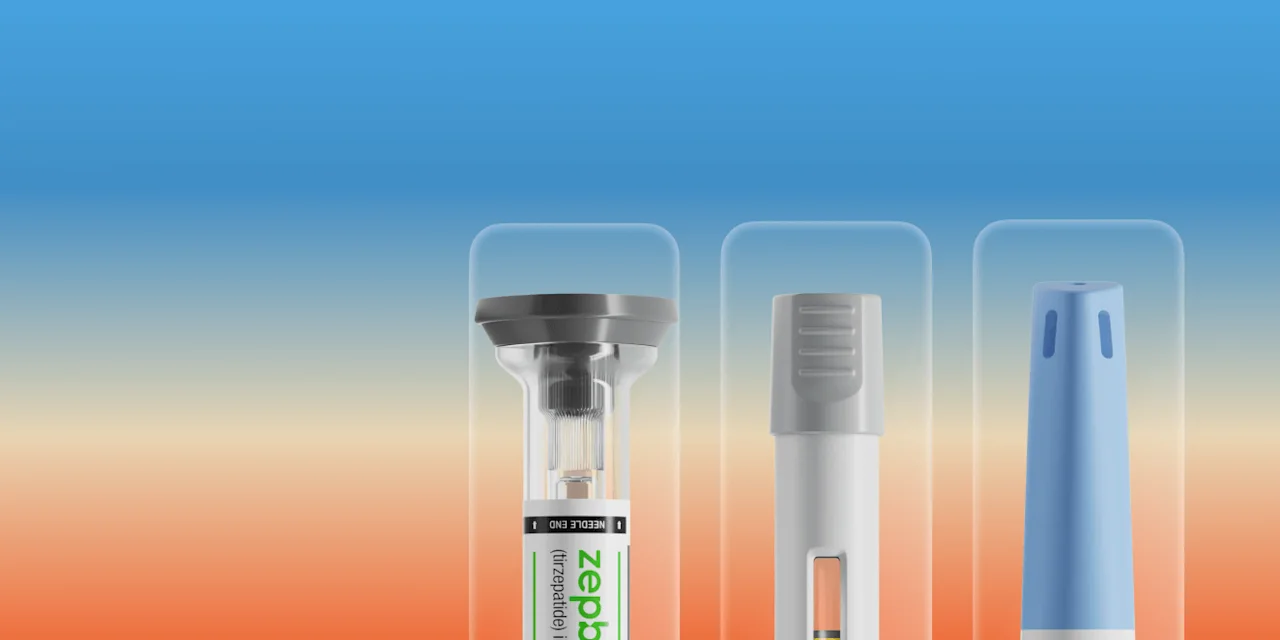Key takeaways
Several injectable medications can help you lose weight, including Mounjaro, Zepbound, Wegovy, Ozempic, and others.
Depending on which medication you use, people may lose an average of 4% – 21% of their body weight.
These medications differ in terms of price and in terms of side effects.
Here's what we'll cover
Key takeaways
Several injectable medications can help you lose weight, including Mounjaro, Zepbound, Wegovy, Ozempic, and others.
Depending on which medication you use, people may lose an average of 4% – 21% of their body weight.
These medications differ in terms of price and in terms of side effects.
It’s safe to say that weight loss injections have taken over the zeitgeist these past few years. Whether you’ve seen an ad on TV (O-o-o-o-zempic, anyone?), scrolled through TikToks of people sharing their weight loss journeys, or know someone personally who is taking the medication, weight loss injections seem to be everywhere.
For those who struggle to lose weight with diet and exercise alone, these injectable medications for weight loss can be a game-changer. If that’s you, read on. We’ll review today’s best weight loss injections so you can have the information you need when you visit your healthcare provider.
What is the best injection for weight loss?
There are several injectable medications for weight loss available. You may know some of the brand names — Ozempic or Wegovy, for instance — but these are actually just some of the many weight loss injections you can get. Below, we will review studies that show how effective these medications are when it comes to weight loss. But, in reality, it’s not about finding the “best” injection for weight loss but finding the best injection for weight loss for you. This can depend on a number of factors, including your:
Age
Body mass index (BMI)
Underlying health conditions
Other medications you are taking
Tolerance for side effects
Insurance coverage
Some of these medications are officially FDA-approved for weight loss, such as Wegovy, Zepbound, and Saxenda. Others, including Mounjaro and Ozempic, are approved to treat other conditions, namely type 2 diabetes, but they may be prescribed off-label for weight loss. Others still have not been approved by the FDA for weight loss, but some research suggests they may be effective in producing weight loss. Let’s take a look.
Tirzepatide
Tirzepatide is the active ingredient in the brand name drugs Mounjaro and Zepbound, and in compounded tirzepatide. Tirzepatide activates two receptors: the glucose-dependent insulinotropic polypeptide (GIP) receptor and the glucagon-like peptide-1 (GLP-1) receptor. That’s a lot of words to say that it works by mimicking two gut hormones naturally produced by your body that are involved in insulin production and appetite regulation.
The dual-receptor targeting of tirzepatide may explain what makes it more effective than similar drugs that target only one receptor, like semaglutide (the active ingredient in Wegovy and Ozempic) and liraglutide (the active ingredient in Victoza and Saxenda), all of which only target the GLP-1 receptor.
Different formulations of tirzepatide may be prescribed to treat type 2 diabetes or weight loss. Tirzepatide helps with weight loss by slowing down digestion, leaving food in your stomach longer, and making you feel full sooner. For type 2 diabetes, it helps lower blood sugar levels after you eat by encouraging the release of insulin while simultaneously limiting the release of glucagon (which spikes your appetite and increases your blood sugar).
Mounjaro
Mounjaro is one of the brand names of tirzepatide. It’s a once-weekly injectable medication made by Eli Lilly. It is FDA-approved to treat type 2 diabetes in adults, when combined with diet and exercise, but may be prescribed off-label for weight loss. Mounjaro is available in six dosage strengths: 2.5 mg, 5 mg, 7.5 mg, 10 mg, 12.5 mg, and 15 mg. In order to minimize side effects, health providers typically prescribe a lower starting dose and slowly titrate up your dose every few weeks until you reach a dosage that gives you maximum effectiveness with minimum side effects.
In clinical trials of Mounjaro, adults with type 2 diabetes lost between 6% – 8% of their body weight in about 10 months. Among people with obesity, but not type 2 diabetes, taking Mounjaro led to an average weight loss of 15% – 21% in about a year and a half, making it one of the most effective weight loss injections so far. Studies of similar medications (but not Mounjaro) have found that people with type 2 diabetes who take these injectable weight-loss medications may lose slightly less weight than those without type 2 diabetes.
The weight loss achieved with Mounjaro appears to be dose-dependent, meaning that people who are taking higher doses tend to lose more weight faster. The same goes for Mounjaro’s side effects, which commonly include nausea, diarrhea, vomiting, and other digestive side effects, and also can be more severe with higher doses. These side effects are most common when starting Mounjaro or right after increasing the dosage, but fortunately tend to lessen with time as your body gets used to the medication.
Zepbound
Once researchers learned how effective Mounjaro was at producing weight loss, Eli Lilly worked with the FDA to fast-track its approval for weight management under a separate brand name. That brand name is Zepbound (tirzepatide). Released in late 2023, Zepbound is one of the newest weight loss injections on the market. When used in combination with diet and exercise, Zepbound is designed to treat chronic weight management in adults with a BMI of:
30 or higher (defined as “obesity”)
27 or higher (defined as “overweight”) and a weight-related health condition such as type 2 diabetes, obstructive sleep apnea, heart disease, high blood pressure, or high cholesterol
Similar to Mounjaro, weight loss is dose-dependent with Zepbound, so people taking higher dosage strengths tend to lose more weight. After a year and a half of taking Zepbound, people in clinical trials lost an average of:
15% of their body weight, or 35.5 pounds, on the 5 mg dose
19.5% of their body weight, or 49 pounds, on the 10 mg dose
20.9% of their body weight, or 52 pounds, on the 15 mg dose
Zepbound is a once-weekly injectable medication, available in six dosage strengths: 2.5 mg, 5 mg, 7.5 mg, 10 mg, 12.5 mg, and 15 mg. As with Mounjaro, health providers typically prescribe a lower starting dose, before gradually ramping you up to the most effective dose for you. Side effects are typically gastrointestinal in nature, with nausea, diarrhea, and vomiting being most intense when you start taking Zepbound, and gradually going away as you get used to the medication.
Compounded tirzepatide
Compounded tirzepatide describes versions of Zepbound or Mounjaro that are produced for individual patients by a compounding pharmacy. Compounded medications, including compounded tirzepatide, are not reviewed or approved by the FDA. However, they can be a good fit in many situations, such as when:
A patient is allergic to an inactive ingredient in the medication, such as a dye. The compounding pharmacy can make a version of the medication that does not contain that ingredient.
A patient is unable to take the medication in its current form. If a patient cannot swallow a tablet, for example, the compounding pharmacy may make a liquid version of the medication.
A medication is experiencing a drug shortage. Compounding pharmacies can make copies of the medication to help meet demand until supply returns to normal.
Because compounded medications do not undergo the same FDA approval process, it is important to do your own due diligence when taking compounded tirzepatide. Make sure that the pharmacy is licensed with a US-based address.
Semaglutide
Semaglutide is the active ingredient in the brand name drugs, Wegovy and Ozempic. Wegovy is FDA-approved for weight loss, while Ozempic is FDA-approved to treat type 2 diabetes (although it may also be prescribed off-label for weight loss).
As a GLP-1 receptor agonist, semaglutide works for weight loss by slowing down digestion. When you take semaglutide, food stays in your stomach longer, so you feel full sooner and eat less as a result. Similar to other GLP-1 receptor agonists, semaglutide also appears to have an effect on the parts of your brain that regulate your appetite. Studies have found that people taking semaglutide report less hunger, a better ability to control how much they eat, and even reduced cravings for certain foods, including high-calorie foods.
Wegovy
Wegovy (semaglutide) is a once-weekly injectable medication for weight loss made by Novo Nordisk. Wegovy is intended for children with obesity and adults with a BMI of:
30 or higher (defined as “obesity”)
27 or higher (defined as “overweight”) and a weight-related health condition such as type 2 diabetes, high blood pressure, or high cholesterol
Healthcare providers typically prescribe Wegovy at a starting dose of 0.25 mg. Over a period of a few weeks, they will typically ramp up your dosage of Wegovy until the maintenance dosage of 2.4 mg is reached. On average, people taking the highest dose of Wegovy lose about 15% of their body weight within a year and a half of starting treatment — and continue losing weight two years and beyond. At a two-year follow-up, people taking Wegovy also reported reduced cravings for dairy, starchy, salty, and spicy foods, as well as a better ability to resist cravings in general.
The most common side effects with Wegovy are nausea and diarrhea, although those tend to go away with time.
Ozempic
Ozempic (semaglutide) is another once-weekly injectable medication made by Novo Nordisk. While it may be prescribed off-label for weight loss, it is FDA-approved to treat adults with type 2 diabetes by:
Keeping blood sugar levels in check (when combined with diet and exercise)
Reducing cardiovascular risk in those who also have heart disease
While Ozempic contains the same active ingredient as Wegovy, it is available in lower dosage strengths. Health providers typically begin with a starting dose of 0.25 mg weekly. Then, they will slowly increase your dosage of Ozempic until a maintenance dose of 1 mg or 2 mg is reached. Nausea, vomiting, and diarrhea are the most common side effects of Ozempic. These range from mild to moderate, and are most frequent when starting treatment.
In one study, people with type 2 diabetes lost an average of 11 pounds within three months of starting Ozempic. After thirty weeks, they had lost 4% – 5% of their body weight.
Liraglutide
Liraglutide is the active ingredient in the brand-name drugs Victoza and Saxenda. Similar to Mounjaro and Zepbound, and Ozempic and Wegovy before that, the drug makers originally developed liraglutide to treat type 2 diabetes. Once they realized its efficacy at producing weight loss, they developed a new version with higher dosage strengths to treat weight management. In the case of liraglutide, that version is Saxenda.
Saxenda (liraglutide) is a GLP-1 receptor agonist that is FDA-approved for weight loss in children with obesity, as well as adults with a BMI of:
30 or higher (defined as “obesity”)
27 or higher (defined as “overweight”) and a weight-related health condition such as type 2 diabetes, high blood pressure, or high cholesterol
Like many weight loss injections, Saxenda is most effective when combined with diet and exercise. However, a key difference between Saxenda and the other GLP-1 medications on this list is that it is a once-daily medication. Health providers may prescribe an initial dose of 0.6 mg daily, before slowly ramping up to the maximum Saxenda dosage of 3 mg daily.
On average, people taking Saxenda lose 8% of their body weight within a year, although one small study documented an average weight loss of 9% within just four months. Nausea, diarrhea, and constipation are the most common side effects of Saxenda.
Vitamin B12
Large-scale studies of B12 have found that adults with lower B12 levels are more likely to be obese. By the same token, those with higher B12 levels were less likely to be obese. So, one might assume that getting a B12 shot may lead to weight loss. However, there isn’t any evidence that this is the case — at least not yet.
Animal studies have found that giving rats supplemental B12 slowed weight gain by revving up their metabolism. As for humans, however, scientists have yet to determine whether the link between B12 and weight loss is causation or correlation. While side effects are rare, some people may find B12 injections to be painful.
Botox
You may be familiar with Botox as a treatment for facial wrinkles. However, botulinum toxin (or botox for short) may actually be used to treat a number of conditions, including weight loss. And while other weight loss shots involve a tiny needle you use on your own to give yourself a shot just under the surface of your skin, Botox shots are intragastric, meaning a doctor puts a tube down your throat under sedation or general anesthesia and gives you the shot from the inside of your stomach. Yikes.
Still, the evidence for Botox as a treatment for weight loss isn’t definitive. For example, a 2017 review of six studies found that botox injections in the stomach led to a weight loss of less than 1%. But, a more recent 2022 review found that the treatment may be effective when given in high enough doses and when combined with a strict diet, though they’re study results were based on too small a population to make any definitive claims.
What are the side effects of injections for weight loss?
When it comes to weight loss injections, side effects can vary depending on the medication and the person. The most common side effects of GLP-1 agonists include:
Nausea
Vomiting
Diarrhea
Constipation
Abdominal pain
Upset stomach or indigestion
Other side effects of GLP-1 injections may include:
Reactions at the injection site
Headaches
Dizziness
Bloating
Belching
Flatulence
Acid reflux
Fatigue
Cold-like symptoms
Stomach flu
Urinary tract infections (UTI)
Insomnia
Dry mouth
Anxiety
Potentially serious side effects can occur, and some people may be at increased risk when taking these medications. For example, there is some evidence from animal studies that taking GLP-1 injections may increase the risk of thyroid cancer. Before starting weight loss injections, inform your healthcare provider of any underlying health conditions you have, and give them a full list of any medications you are taking.
How much do injections for weight loss cost?
The cost of weight loss injections can vary dramatically, depending on whether you’re taking a prescription medication or getting Botox or a B12 shot. Here is a breakdown of average costs:
Mounjaro costs $1,069 for a 1-month supply.
Zepbound costs $1,060 for a 1-month supply.
Wegovy costs $1,349 for a 1-month supply.
Ozempic costs $936 for a 1-month supply.
Saxenda costs $1,349 for a 1-month supply.
B12 shots cost $35 to $80 per injection.
Botox costs $528 per injection.
The prices above are an estimate, and may vary based on your location, pharmacy, and insurance coverage. Many of the drug makers behind prescription weight loss injections offer savings cards that can dramatically bring down the cost, especially if you have insurance. You may also find a better price by calling different pharmacies in your area. Botox and B12 shot prices are set by the provider, and different clinics may offer deals for first-time patients or bundle pricing.
If you want to learn more about weight loss shots and how you can get access to a weight loss program from the comfort of your own home, check out the Ro Body program. A US-licensed healthcare provider can evaluate your medical history and determine if treatment with GLP-1s is right for you.
DISCLAIMER
If you have any medical questions or concerns, please talk to your healthcare provider. The articles on Health Guide are underpinned by peer-reviewed research and information drawn from medical societies and governmental agencies. However, they are not a substitute for professional medical advice, diagnosis, or treatment.
Ozempic Important Safety Information: Read more about serious warnings and safety info.
Wegovy Important Safety Information: Read more about serious warnings and safety info.
Zepbound Important Safety Information: Read more about serious warnings and safety info.
Saxenda Important Safety Information: Read more about serious warnings and safety info.
Mounjaro Important Safety Information: Read more about serious warnings and safety info.
American Society of Plastic Surgeons. (2024). How much do botulinum toxin injections cost?. Retrieved from https://www.plasticsurgery.org/cosmetic-procedures/botulinum-toxin/cost
Bezin, J., Gouverneur, A., Pénichon, M., et al. (2023). GLP-1 Receptor Agonists and the Risk of Thyroid Cancer. Diabetes Care, 46(2), 384–390. doi:10.2337/dc22-1148. Retrieved from https://pubmed.ncbi.nlm.nih.gov/36356111/
Blundell, J., Finlayson, G., Axelsen, M., et al. (2017). Effects of once-weekly semaglutide on appetite, energy intake, control of eating, food preference and body weight in subjects with obesity. Diabetes, Obesity & Metabolism, 19(9), 1242–1251. doi:10.1111/dom.12932. Retrieved from https://www.ncbi.nlm.nih.gov/pmc/articles/PMC5573908/
Bustamante, F., Brunaldi, V. O., Bernardo, W. M., et al. (2017). Obesity Treatment with Botulinum Toxin-A Is Not Effective: a Systematic Review and Meta-Analysis. Obesity Surgery, 27(10), 2716–2723. doi:10.1007/s11695-017-2857-5. Retrieved from https://pubmed.ncbi.nlm.nih.gov/28812212/
Collins, L. & Costello, R. A. (2023). Glucagon-Like Peptide-1 Receptor Agonists. StatPearls. Retrieved from https://www.ncbi.nlm.nih.gov/books/NBK551568/
Eli Lilly. (2022). Lilly receives U.S. FDA Fast Track designation for tirzepatide for the treatment of adults with obesity, or overweight with weight-related comorbidities. Lilly Investors. Retrieved from https://investor.lilly.com/news-releases/news-release-details/lilly-receives-us-fda-fast-track-designation-tirzepatide
Eli Lilly-a. (2023). How much should I expect to pay for Mounjaro®? Retrieved from https://www.lillypricinginfo.com/mounjaro
Eli Lilly-b. (2023). FDA Approves Lilly's Zepbound™ (tirzepatide) for Chronic Weight Management, a Powerful New Option for the Treatment of Obesity or Overweight with Weight-Related Medical Problems. Lilly Investors. Retrieved from https://investor.lilly.com/news-releases/news-release-details/fda-approves-lillys-zepboundtm-tirzepatide-chronic-weight
Fisman, E. Z. & Tenenbaum, A. (2021). The dual glucose-dependent insulinotropic polypeptide (GIP) and glucagon-like peptide-1 (GLP-1) receptor agonist tirzepatide: a novel cardiometabolic therapeutic prospect. Cardiovascular Diabetology, 20(1), 225. doi:10.1186/s12933-021-01412-5. Retrieved from https://www.ncbi.nlm.nih.gov/pmc/articles/PMC8613929/
Frías, J. P., Davies, M. J., Rosenstock, J., et al. (2021). Tirzepatide versus Semaglutide Once Weekly in Patients with Type 2 Diabetes. The New England Journal of Medicine, 385(6), 503–515. doi:10.1056/NEJMoa2107519. Retrieved from https://www.nejm.org/doi/10.1056/NEJMoa2107519?
Garvey, W. T., Batterham, R. L., Bhatta, M., et al. (2022). Two-year effects of semaglutide in adults with overweight or obesity: the STEP 5 trial. Nature Medicine, 28(10), 2083–2091. doi:10.1038/s41591-022-02026-4. Retrieved from https://pubmed.ncbi.nlm.nih.gov/36216945/
Jastreboff, A. M., Aronne, L. J., Ahmad, N. N., et al. (2022). Tirzepatide Once Weekly for the Treatment of Obesity. The New England Journal of Medicine, 387(3), 205–216. doi:10.1056/NEJMoa2206038. Retrieved from https://www.nejm.org/doi/full/10.1056/NEJMoa2206038
Jensterle, M., Rizzo, M., Haluzík, M., et al. (2022). Efficacy of GLP-1 RA Approved for Weight Management in Patients With or Without Diabetes: A Narrative Review. Advances in Therapy, 39(6), 2452–2467. doi:10.1007/s12325-022-02153-x. Retrieved from https://www.ncbi.nlm.nih.gov/pmc/articles/PMC9063254/
Kaya, B., Esen Bulut, N., & Fersahoglu, M. (2020). Is Intragastric Botulinum Toxin A Injection Effective in Obesity Treatment?. Surgery Research and Practice, 2020, 2419491. doi:10.1155/2020/2419491. Retrieved from https://www.ncbi.nlm.nih.gov/pmc/articles/PMC7547330/
Mehta, A., Marso, S. P., & Neeland, I. J. (2017). Liraglutide for weight management: a critical review of the evidence. Obesity Science & Practice, 3(1), 3–14. doi:10.1002/osp4.84. Retrieved from https://www.ncbi.nlm.nih.gov/pmc/articles/PMC5358074/
NovoCare-a. (2023). What is the list price for Wegovy® and will it impact me?. Retrieved from https://www.novocare.com/obesity/products/wegovy/let-us-help/explaining-list-price.html
NovoCare-b. (2023). Find out the cost for Ozempic®. Retrieved from https://www.novocare.com/diabetes/products/ozempic/explaining-list-price.html
NovoCare-c. (2023). What is the list price for Saxenda® and will it impact me?. Retrieved from https://www.novocare.com/obesity/products/saxenda/explaining-list-price.html
Sun, Y., Sun, M., Liu, B., et al. (2019). Inverse Association Between Serum Vitamin B12 Concentration and Obesity Among Adults in the United States. Frontiers in Endocrinology, 10, 414. doi:10.3389/fendo.2019.00414. Retrieved from https://www.ncbi.nlm.nih.gov/pmc/articles/PMC6610317/
Trenson, L., Trenson, S., van Nes, F., et al. (2022). Liraglutide for Weight Management in the Real World: Significant Weight Loss Even if the Maximal Daily Dose Is Not Achieved. Obesity Facts, 15(1), 83–89. doi:10.1159/000520217. Retrieved from https://www.ncbi.nlm.nih.gov/pmc/articles/PMC8820228/ \
U.S. Food & Drug Administration (FDA-a). (2022). Mounjaro (tirzepatide) Injection, for subcutaneous use. Retrieved from https://www.accessdata.fda.gov/drugsatfda_docs/label/2022/215866s000lbl.pdf
U.S. Food & Drug Administration (FDA-a). (2023). Zepbound (tirzepatide) Injection, for subcutaneous use. Retrieved from https://www.accessdata.fda.gov/drugsatfda_docs/label/2023/217806s000lbl.pdf
U.S. Food & Drug Administration (FDA-b). (2023). FDA Approves New Medication for Chronic Weight Management. Retrieved from https://www.fda.gov/news-events/press-announcements/fda-approves-new-medication-chronic-weight-management
U.S. Food & Drug Administration (FDA-b). (2022). Compounding and the FDA: Questions and Answers. Retrieved from https://www.fda.gov/drugs/human-drug-compounding/compounding-and-fda-questions-and-answers
U.S. Food & Drug Administration (FDA-c). (2023). Drug Compounding and Drug Shortages. Retrieved from https://www.fda.gov/drugs/human-drug-compounding/drug-compounding-and-drug-shortages
U.S. Food & Drug Administration (FDA-d). (2023). Wegovy (semaglutide) Injection, for subcutaneous use. Retrieved from https://www.accessdata.fda.gov/drugsatfda_docs/label/2023/215256s007lbl.pdf
U.S. Food & Drug Administration (FDA-e). (2023). Ozempic (semaglutide) Injection, for subcutaneous use. Retrieved from https://www.accessdata.fda.gov/drugsatfda_docs/label/2023/209637s020s021lbl.pdf
U.S. Food & Drug Administration (FDA-c). (2022). Saxenda (liraglutide) Injection, for subcutaneous use. Retrieved from https://www.accessdata.fda.gov/drugsatfda_docs/label/2022/206321s015lbl.pdf
Wang, H., Li, L., Qin, L. L., et al. (2018). Oral vitamin B12 versus intramuscular vitamin B12 for vitamin B12 deficiency. The Cochrane Database of Systematic Reviews, 3(3), CD004655. doi:10.1002/14651858.CD004655.pub3. Retrieved from https://www.ncbi.nlm.nih.gov/pmc/articles/PMC6494183/
Wharton, S., Batterham, R. L., Bhatta, M., et al. (2023). Two-year effect of semaglutide 2.4 mg on control of eating in adults with overweight/obesity: STEP 5. Obesity (Silver Spring, Md.), 31(3), 703–715. doi:10.1002/oby.23673. https://pubmed.ncbi.nlm.nih.gov/36655300/
Wilding, J. P. H., Batterham, R. L., Calanna, S., et al. (2021). Once-Weekly Semaglutide in Adults with Overweight or Obesity. The New England Journal of Medicine, 384(11), 989–1002. doi:10.1056/NEJMoa2032183. Retrieved from https://pubmed.ncbi.nlm.nih.gov/33567185/
Yen, Y. A., Wang, C. C., Sung, W. W., et al. (2022). Intragastric injection of botulinum toxin A for weight loss: A systematic review and meta-analysis of randomized controlled trials. Journal of Gastroenterology and Hepatology, 37(6), 983–992. doi:10.1111/jgh.15847. Retrieved from https://pubmed.ncbi.nlm.nih.gov/35383416/
Zheng, Y., Ma, A. G., Zheng, M. C., et al. (2018). B Vitamins Can Reduce Body Weight Gain by Increasing Metabolism-related Enzyme Activities in Rats Fed on a High-Fat Diet. Current Medical Science, 38(1), 174–183. doi:10.1007/s11596-018-1862-9. Retrieved from https://pubmed.ncbi.nlm.nih.gov/30074168/













